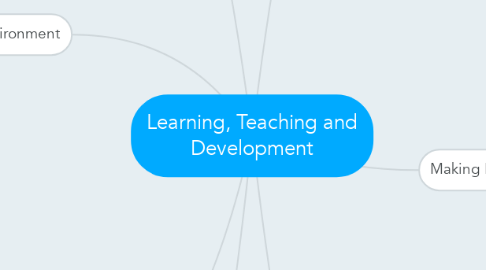
1. Positive Learning Environment
1.1. Dynamic Classroom management
1.1.1. Establish Guidelines
1.1.2. Be Clear
1.1.3. Students should be reflecting on how they'll behave
1.2. Develop realistic expectaitons
1.2.1. Then promote them
1.3. Provide Positive feedback
1.3.1. As well give constructive feed back when needed
1.4. Respond to students
1.4.1. support them
1.5. Develop relationships with students
1.5.1. Make the feel welcome and safe in the classroom
1.5.2. Make yourself available when needed to support those who need it
1.6. Mutual agreeable rules
2. Development Differences
2.1. Development Influences
2.1.1. Physical
2.1.2. Cognative
2.1.3. Social Changes
2.1.4. Personal
2.1.4.1. The Self
2.1.4.1.1. Self Esteem
2.2. Principles of Develoment
2.2.1. Gradual
2.2.2. Orderly
2.2.3. Different rates
2.2.4. Nature and Nurture
2.3. Jean Piaget
2.3.1. Interest in the ability to Adapt
2.3.2. Brain naturally looks for patterns
2.4. Moral Development
2.5. Vygotsky
2.5.1. Students learn better with some assistance
2.5.2. Importance of Social interactions and shared social activities
2.6. Growth mindset
3. Planning for the School Year
3.1. Become a Reflective Practitioner
3.1.1. Reflect on your practice
3.1.2. Assess the effects of your teaching
3.2. Ask good questions
3.3. Classroom behavior management
3.3.1. Engage Students
3.3.2. Establish a calm atmosphere
3.3.3. Promote creativity
4. Individual Differences
4.1. General intelligence
4.1.1. Then a plethora of different types of intelligence's
4.2. Fluid intelligence
4.2.1. ability to understand abstract and new concepts, by seeing patterns
4.3. Crystallized intelligence
4.3.1. Ability to apply culturally and environmentally influenced problem solving skills
4.4. Visual/spatial reasoning
4.4.1. ability to use and manipulate visual images
4.5. Multiple theories on intelligence
4.5.1. Gardner
4.5.2. Sternberg
4.6. Source of intelligence
4.6.1. Mix of both nature and nurture
4.7. Special Education
4.7.1. high-incidence exceptionalities
4.7.2. Low-incidence exceptionalities
4.7.3. Controversy of inclusion
4.7.3.1. Build an inclusive practice
4.7.3.1.1. Build a supportive classroom
4.7.4. Be prapared
4.7.5. Individualized education programs
5. Socio-Cultural
5.1. Encourage diveristy
5.2. Seek to eliminate disparities
5.3. Celebrate all cultures
5.3.1. Be aware students family and communities
5.3.2. Have a knowledge about social, cultural and language backgrounds
5.3.2.1. Needed in order to teach all students
5.4. Student race/culture/gender/ socio-economic status, all influence how students will learn
5.5. Having a intimate understandings of diversity students is both important and useful for the harmony of the classroom
5.6. Critical consciousness
5.6.1. recognizing that peoples ways of thinking are influenced by
5.6.1.1. Race
5.6.1.2. class
5.6.1.3. gender
5.6.1.4. language
5.7. Avoid stereotypes and prejudice thinking
5.8. Multicultural education
5.8.1. Being aware of Canada's mosiac
6. Making Instructional Decisions
6.1. Backward design
6.1.1. What do you want students to learn
6.1.2. How to determine if they learned it
6.1.3. What will you teach
6.1.4. How will you teach it
6.2. Create daily lesson plans
6.2.1. Always have a backup just encase something goes wrong
6.2.2. Lessons should promote creativity, curiosity and collobration
6.3. Blooms Taxonomy
6.3.1. Knowledge
6.3.2. Comprehension
6.3.3. Application
6.3.4. Analysis
6.3.5. Synthesis
6.3.6. Evaluation
6.3.7. Clearly separates different types and goals of thinking
6.3.8. It's a hierarchy of intellectual abilities
6.4. Metacognition
6.4.1. executive thinking processes, such as planning, gauging comprehension, and evaluating, that actively control the cognitive process that become engaged when the brain is required to think or learn
6.5. Creating those classroom relationships
6.5.1. Students are more motivated when they feel their teacher cares about them
6.5.2. Intrinsic and Extrinsic motivation
7. Assessing Student Learning
7.1. Don't misuse homework
7.2. Homework has benefits
7.2.1. Make the homework small and easily manageable
7.3. Diagnostic Assessment
7.3.1. See where the students are at
7.3.2. determine starting points
7.4. Formative Assessment
7.4.1. Get a sense of the students understanding
7.4.2. asking questions
7.4.3. group work or seat work
7.4.4. Also assigning work to accumulate grades
7.5. Summative Assessment
7.5.1. How well the students have learned the material
7.6. Types of assessment questons
7.6.1. Blooms taxonomy
